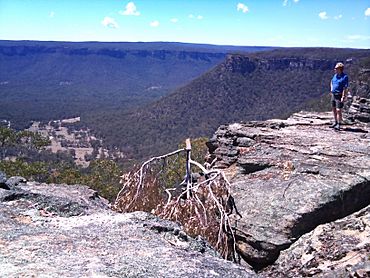Gardens of Stone National Park facts for kids
Quick facts for kids Gardens of Stone National ParkNew South Wales |
|
|---|---|
|
IUCN Category II (National Park)
|
|

A view of the natural stone pagodas in the national park
|
|
| Nearest town or city | Lithgow |
| Established | 30 November 1994 |
| Area | 150.8 km2 (58.2 sq mi) |
| Managing authorities | NSW National Parks & Wildlife Service |
| Website | Gardens of Stone National Park |
| See also | Protected areas of New South Wales |
The Gardens of Stone National Park is a special protected area in New South Wales, eastern Australia. It's like a huge natural playground covering about 15,080 hectares (that's about 37,260 acres!). You can find it about 125 kilometers (78 miles) northwest of Sydney. The park gets its cool name from the amazing stone shapes inside it, which look a bit like pagodas.
This park is super important! In 2000, it became part of the UNESCO World Heritage-listed Greater Blue Mountains Area. This means it's recognized as a special place for everyone in the world to protect. It's also part of the big Great Dividing Range mountains.
Contents
Exploring the Park's Amazing Features
What makes Gardens of Stone National Park so unique? The most eye-catching parts are its huge sandstone cliffs and canyons. You'll also see cool rock formations called pagodas.
But there's more! The park has unusual limestone areas and special elevated swamps. These features make the park a really interesting place to explore.
Where is the Park Located?
The park has clear boundaries. To the west, you'll find the Castlereagh Highway. The Glen Davis Road is to the north. On its eastern side, it touches the Wollemi National Park. To the south, it's next to the Newnes State Forest, the Wolgan Valley, and the Wolgan State Forest.
Small towns like Capertee, Ben Bullen, and Glen Davis are located right on the edge of this national park.
A Brief History of the Park
People have wanted to protect this area for a long time. Back in 1932, there was an idea to make the Newnes Plateau region part of a bigger Blue Mountains National Park.
Later, in 1979, the Wollemi National Park was created. This made people even more keen to protect the Gardens of Stone area. In 1984, a group called the National Parks Association suggested making the park bigger.
How the Park Was Established
This idea grew into a detailed plan in 1993 for a park covering 18,030 hectares. This plan was successful! The Gardens of Stone National Park was officially created in 1994.
However, the first park was a bit smaller, at 11,780 hectares. Some areas with coal were left out. Later, the park was made larger, reaching its current size of 15,080 hectares. Environmental groups are still working to protect even more of the surrounding land. This includes more pagodas, canyons, heathland, and elevated swamps.
Plants and Animals of the Park
The Gardens of Stone National Park is home to many different living things. Scientists have found 423 types of native plants here! These plants grow in 30 different groups, or "communities."
Most of the park is covered in open forests or woodlands. These areas are filled with different kinds of eucalyptus trees.
Unique Habitats and Rare Species
In the western part of the park, you'll find woodlands with ironbark and yellow box trees. These trees grow on special clay soil. This area is a home for some rare birds, like the regent honeyeater and the turquoise parrot.
In the southwest, there's white box woodland. On the eastern edges, you'll see scribbly gum woodlands.
Protecting Fragile Ecosystems
The plants and animals living on the pagoda formations are very delicate. Human activities can easily damage them forever. For example, if people collect rocks from the bush for their gardens, it removes homes for reptiles. It's important to be careful and respect these natural areas.
See also
 In Spanish: Parque nacional Jardines de Piedra para niños
In Spanish: Parque nacional Jardines de Piedra para niños


